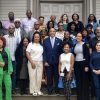Racial discrimination in cases like the Arbery murder trial reflect the everyday reality of the criminal legal system.
On November 24, 12 carefully selected jurors in Brunswick, Georgia, convicted three men accused of murdering Ahmaud Arbery as he jogged through their neighborhood. The men, who are all white, claimed they shot and killed the Black and unarmed Arbery in self-defense.
This verdict arrives despite efforts to tip the scales of justice in the murderers’ favor. Eleven of the 12 jurors were white, and that racial composition was no accident. During jury selection, the defense dismissed 11 of 12 potential Black jurors. When the prosecution challenged these dismissals, Judge Timothy Walmsley acknowledged that they were likely rooted in racism but refused to do anything about it.
“The jury should represent the community,” says Stephen Bright, a lawyer and professor at Yale University. “And a community that’s 27 percent African American should have more than one Black person on the jury.”
About 550 miles north, in Charlottesville, Virginia, a Black juror in the trial against white supremacists who organized the deadly, 2017 “Unite the Right” rally declared himself unconcerned with “racism against white/Caucasian people.” The defense dismissed the juror but didn’t do the same for white jurors who answered similarly. As in the Arbery trial, the prosecution challenged the dismissal. And, as in the Arbery trial, the judge refused to take action.
Fury erupted at these judges almost immediately. Yet many activists and legal experts say the problem does not principally lie with the judges but with the law itself.
“None of the egregious things that have happened in any of these trials are outside of the bounds of American law,” says Cat Brooks, co-founder of the Anti Police-Terror Project (APTP). Scott Roberts, senior director of criminal justice campaigns for Color of Change, agrees. He points to the case of Judge Olu Stevens in 2016, who threw out an all-white jury on racial grounds. “He recognized that discrimination was happening, … and he was suspended for 90 days.”
Racial discrimination in high-profile cases like the Arbery murder trial and the Unite the Right civil suit reflect the day-to-day reality of the United States criminal legal system. While the juries in both trials ruled against the white defendants, this kind of outcome is far from a given.
“These are extraordinary cases. What we really ought to worry about is the day to day,” Bright says. “The criminal justice system is the part of society least affected by the civil rights movement. We still have all-white juries today, in 2021, this many years after the Civil War.”
A Shallow Jury Pool
The racialized skewing of the jury pool begins early, when jurisdictions send jury summons in the mail. If you are a person of color, your odds of receiving one are far lower than your white neighbors.
According to the Equal Justice Initiative (EJI), most jurisdictions use drivers’ license records and voter registration to develop a list of potential jurors. But many people who are impoverished or live in the city do not have drivers’ licenses and are not registered to vote. Both processes require time and documents that many Black citizens cannot spare due to structural inequality.
To make matters worse, Black people are nearly three times as likely to have a felony conviction on their record, which prevents voter registration in the vast majority of the U.S. “If you’re barred from registering to vote, then you’re barred from juries by default,” Color of Change’s Roberts says. “Given that our criminal justice system is so racially biased, … this is a vicious cycle.”
Because Black people and other people of color suffer disproportionate economic hardships, those who make it into the jury pool often face further obstacles. Low-income people move more often, which means summons are often sent to outdated addresses. Moreover, many cannot afford to take time off work to serve on jury duty, which pays less than minimum wage in 49 states. The result: a jury pool that skews white and wealthy — hardly representative of the overall community.
“It’s almost as if the system says, ‘Well, we get to discriminate against you again because you’ve been discriminated against in all these other areas of the system.’”
These whiter, wealthier jury pools have a measurable effect on trial results. A University of Chicago study compared jury pools composed of less than 22 percent white men with those composed of more than 39 percent. The jury pools with fewer white men convicted Black defendants 12 percent less often.
Dismissed for Cause
Racial discrimination does not stop after potential jurors arrive at the courthouse. Lawyers for both the prosecution and defense get to question the jury in a process called “Voir Dire,” and can then dismiss potential jurors “for cause” if they believe the juror to be biased.
At this stage, the bias of individual judges can have an enormous effect. Judges decide what questions each side can ask of potential jurors and ultimately rule on whether a given “for cause” reason is sufficient. Because 80 percent of federal judges are white, that bias can be a big problem.
For example, in the Arbery murder trial, Judge Walmsley threw out several of the defense’s most outlandish questions, such as, “Are all white people who use the n-word racists?” and “Is the Confederate flag a symbol of racism?” But he did allow the defense to ask whether potential jurors support Black Lives Matter or think the U.S. criminal legal system is biased against people of color.
The 16-page questionnaire for potential Unite the Right jurors also asked about Black Lives Matter, along with their opinions of “antifa,” support of civil rights groups such as the Anti-Defamation League or the ACLU, and whether they regard statues of Confederate generals as symbols of racism. If the defense did not like an answer, they could dismiss that juror immediately. As described above, this exact scenario unfolded with Juror 197, a Black man who did not, according to the defense, display sufficient concern for racism against white people and was subsequently dismissed from duty.
Accusations of bias against police often figure heavily in excluding non-white jurors. Because of systemic racism throughout the U.S. criminal legal system, Black people and other people of color tend to have more unpleasant experiences with police. Because of these experiences, whichever side intends to call police to the stand tends to claim the juror of color in question cannot be impartial.
“It’s almost as if the system says, ‘Well, we get to discriminate against you again because you’ve been discriminated against in all these other areas of the system,’” says Lila Silverstein, a lawyer with the Washington Appellate Project, an organization that helps people who cannot afford legal representation.
Anything Goes: The Peremptory Strike
If a legal team that desires and fails to achieve an all-white jury during the “for cause” stage of questioning, they have a final weapon in their arsenal: the peremptory challenge.
Each side of a case has a limited amount of peremptory challenges which they can use to dismiss a juror for any reason — that is, unless that reason is racial bias. In 1986, the Supreme Court ruled in Batson v. Kentucky that peremptory challenges cannot rest solely on race. There has to be some other reason as well. The resulting precedent established the “Batson challenge,” in which a legal team can challenge the other side’s peremptory dismissal of a juror if they believe that dismissal is based on race.
So how did the defense team for Arbery’s accused murderers get away with eliminating 11 of 12 potential Black jurors, even though Judge Walmsley acknowledged a clear racial motivation for these eliminations?
Because “equal protection under Batson has utterly failed,” Silverstein tells Truthout.
The bar for sustaining a Batson challenge is almost impossibly high. The side that issued a peremptory strike has to supply some reason other than race to justify their decision. Because peremptory strikes can be based on anything other than race, the given reason can be anything: a haircut the legal team does not like, a rolling of the juror’s eyes during the proceedings, or even an earring.
“Those are all reasons that have been upheld,” Bright says. “Prosecutors have lists of reasons. So they don’t even have to have a real reason, they just look down and read a reason. And almost always, the judge upholds it.”
Part of the reason judges tend to reject Batson challenges is that, legally speaking, they must accept any excuse. But that’s not the only motivation behind the dismissals.
“Most judges have to deal with these prosecutors day in and day out,” Bright says. “They may be good friends. [The judge] is not going to make a finding that the prosecutor intentionally discriminated…. I mean, that’s serious business to accuse someone of that.”
“Jury Selection Is Everything”
Discrimination against potential jurors of color disenfranchises the individual and erodes faith in the legal system, Washington Appellate Project’s Silverstein says. It violates the constitutional right to a jury of one’s peers. Worse, it materially affects the fate of those accused of a crime.
As Bright puts it, “Many people think, with many cases, that [jury selection] is everything.”
The racial composition of juries also has an enormous impact on conviction rates and sentencing. According to the EJI, “research demonstrates that white jurors are more likely to view Black defendants as coldhearted, remorseless, and dangerous.” A Duke University study found that all-white juries convict Black defendants 16 percent more often than a jury with even one Black member, like the jury in the Arbery murder trial.
Jury composition also affects sentencing. A National Bureau of Economic Research study found that, with a jury that accurately reflected the racial composition of the community, the probability of a Black defendant receiving a life sentence drops by a staggering 67 percent.
Additionally, diverse juries, statistically speaking, just do a better job. A 2006 study found that diverse juries are more likely to take racial bias into account during deliberation. “They deliberate longer, they’re more careful, they can make fewer factual errors and they follow the judge’s instructions better,” Silverstein says.
A Jury of One’s Peers
“Our jury selection process needs to be completely overhauled,” Brooks says.
But her police watchdog coalition has their hands full just dealing with the legal fallout of a racist system. “We provide trauma support for Black, Indigenous, and other people of color.” The group works hard to keep individuals out of the criminal legal system through initiatives like MH First, a mental health hotline and alternative to calling the police. Projects like this one help prevent people from ending up in the hands of a flawed legal system — or worse, shot by police.
Color of Change, a national organization that tackles systemic racism from multiple angles, also acknowledges the difficulty of rooting out entrenched bias within the U.S. legal system. “This has been one of the harder things to take on,” Roberts says. “At the end of the day we need to be able to challenge these juries in the moment”
Washington State recently moved to allow exactly that sort of challenge. General Rule 37, passed in 2018, makes it easier to challenge peremptory strikes. California recently followed suit.
“Unlike the Batson rule, [Rule 37] does not require proof of intentional discrimination in order for a judge to disallow the removal of a juror,” Silverstein explains. Instead, all the challenger has to do is show that an “objective observer” would think that race factored into the peremptory dismissal.
The law takes on “for cause” dismissals as well. Under Rule 37, negative experiences with police are no longer sufficient by themselves to exclude a potential jury member. Lawyers must also establish behavioral reasons for exclusion upfront. “If you think that a juror is not paying attention during the questioning phase, you have to raise the issue when you see it,” Silverstein says. No more scanning down a list of reasons to dismiss someone: The lawyer has to go out of their way to establish their concerns beforehand.
In 2022, Arizona will try a different approach: eliminating peremptory strikes altogether. While this is, according to Silverstein, “better than doing nothing,” lawyers are skeptical about whether this will actually solve the problem. “Most trial lawyers … think that it’s important to have peremptory challenges,” says Silverstein. “They say they want to have the power to be able to excuse jurors who they think will be unfair, even if the judge disagrees with them.”
Bright agrees. Though he believes peremptory strikes should be reduced, elimination means the judge has almost complete control over jury selection. “I think we’ve seen in these cases that the judges are not as down the middle as we would like,” he says.
While these fixes could make jury selection — and judicial outcomes — more equitable, the problem goes far deeper.
Overhauling jury selection may reduce disparities between conviction rates of Black and white people, but it will not eliminate the bias that leads to the discrepancy. It will not reform a carceral state that imprisons a larger percent of its population than any other nation on the planet. It will not change the fact that police forces arrest Black people at a rate five times higher than white people. And it will not undo the legacy of centuries of oppression: systemic racial inequalities in wealth and income.
Brooks says a much deeper overhaul of the criminal legal system is needed.
“It’s about looking at how the court system was built to uphold race-based capitalism and white supremacy,” Brooks says, “and having the courage to look at those systems deeply, and reconfiguring them so that they operate in a more equitable, humane, just way.”
Source: Truthout
Laura Jedeed is a freelance journalist based in New York City who concentrates primarily on housing inequality and the far right. Her work has appeared in Salon, Willamette Week and Portland Monthly Magazine, and her footage has appeared in Newsweek, The Hill, ABC and more.
Featured image: Prosecutor Linda Dunikoski stands in front of Judge Timothy Walmsley during the trial of the three men involved in the shooting of Ahmaud Arbery at Glynn County Superior Court on November 19, 2021, in Brunswick, Georgia. (Octavio Jones-Pool, Getty Images)















